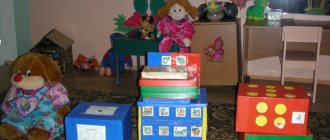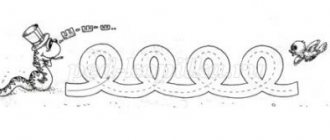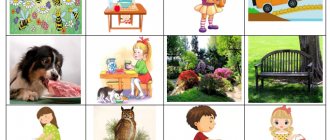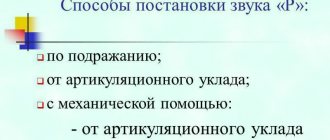Currently, the number of children with speech pathology, including speech disorders such as dysarthria, is growing.
The most common problems in preschoolers with erased dysarthria are violations of the pronunciation of whistling sounds. In this work, the author tried to collect various techniques for producing whistling sounds. Using this collection of techniques for producing sounds, a speech therapist can choose the method most suitable for a given child, taking into account his typological and individual characteristics.
Techniques for producing whistling sounds [З, Зь, Ц]
Characteristics of a group of whistling sounds.
The group of whistling sounds includes the sounds S, S', Z, Z' and Ts (in transcription: [s], [s'], [z], [z'], [ts]). They are classified in the same group because they have similar articulation. For example, the sounds [s] and [z] differ only in the presence or absence of voice, the sounds [s] and [s'] differ in the additional rise of the middle part of the tongue.
[C]: consonant, oral, voiceless, fricative, anterior lingual, hard;
[Z]: consonant, oral, voiced, fricative, anterior lingual, hard;
[S'], [Z']: soft;
[C]: consonant, oral, voiceless, occlusive fricative, anterior lingual, hard.
In the group of whistling sounds, the basis is the articulation of the sound [s]. This sound is the basis for the entire group.
How to pronounce the sound [z] normally.
The sound [z] is a consonant, voiced, hard. Paired with it in softness is the sound [z'] (“z”), Paired in deafness is the sound [s].
When pronouncing the sound [z], the organs of articulation occupy the following position:
— lips
slightly stretched in a smile, so that the upper and lower incisors are exposed;
— teeth
brought closer together, forming a gap of 1-2 mm;
— Tip of the tongue
wide, located in the lower part of the lower front teeth;
— lateral edges of tongue
raised and tightly connected with the upper lateral teeth;
— dorsum of tongue
in its
anterior
part it forms a narrow gap with the upper alveoli for the exit of a stream of air;
— air jet
strong, runs down the middle of the tongue and feels cold when you bring the back of your hand to your mouth;
— soft sky
pressed tightly to the back wall of the throat, preventing air from escaping into the nose;
— vocal cords
closed and trembling, forming a voice.
Ways to stop sound [
z
]
No.
Method of setting
NO SOUND
The sound [z] is placed similarly to the sound [s], characterized by additional phonation of the vocal cords.
By imitation:
a) Discrimination by ear of the sounds [s-z] in words that are similar in sound composition, in syllables, among phonemes (see “Development of phonemic hearing”).
b) Tactile and vibration sensations from the work of the vocal cords. The child puts one hand (the back side) to the speech therapist’s neck, the other hand touches the child’s neck, “sss” - the voice is asleep, “zzz” - the voice is awake. "Mosquito" is ringing.
[h]
- a mosquito, a fly, a wasp rings
By imitation:
The child is offered a sample of sound pronunciation in combination with play images (a mosquito is ringing, a bell is ringing, etc.); At the same time, visual control of correct articulation and tactile (tactile) sensations are used.
From reference sound:
Perform exercises “Fence” - “Mosquito”. By imitation, say “iiiiii-zzzzzz.”
Note: when performing the sound [z], the child is not called, but is replaced with the name of the exercise “Mosquito”.
The sound [z] is easily differentiated from the sound [c], since these sounds have the same articulatory structure, that is, when pronouncing these sounds, the organs of articulation occupy the same position. The difference between the sounds is that [s] is voiceless, pronounced without a voice, and [z] is voiced, pronounced with a voice. Thus, to cause the sound [z], it is enough to add, “turn on” the voice when pronouncing the sound s.
The presence or absence of voice can be controlled by ear, as well as by tactile-vibration control. To do this, apply the back of the hand to the front surface of the neck in the larynx area. When you “turn on” your voice, your hand feels a slight vibration transmitted from the vocal folds. When you turn off the voice, the vibration disappears.
You can explain to children that when the little voice in the neck is “sleeping,” we don’t feel it, but when it wakes up, we can feel it jumping and having fun in its little house—the neck.
Having received the correct sound [z], you should practice pronouncing it for some time in isolation from other sounds: z-z-z. Children can be asked to ring like a mosquito or a bell.
With this sound, the position of the lips, teeth and tongue is the same as with the sound “C”. But this sound “3” is voiced: the folds are closed and vibrate, that is, it is pronounced with a voice. Ego needs to be explained to the child both by ear and by tactile sensation, that is, put the child’s hand on the larynx and pronounce the sounds “C” and “3” alternately. When the sound “3” is heard, the child will feel a vibration in the larynx. We learn to imitate a mosquito. The mosquito flew and rang protractedly - “33333.” For correct imitation you need to: expose all the teeth in a “smile”, the distance between the teeth is approximately 2 mm, the tip of the tongue rests on the upper part of the lower teeth, the exhaled stream goes exactly in the middle of the front incisors to the tip of the tongue, while the voice is involved. You can first start from “I” plus “S”, and then turn on the voice - “ISZZ”. First, the vowel “I” is taken, because with the sound “I” the tip of the tongue reflexively takes its original position, as with “C” or “3”, and at the same time a channel appears at the tip of the tongue through which an air stream moves to the front teeth. It is also possible from the combination “PIS”. The explosive sound “P” creates additional pressure and this helps the child feel the air stream more strongly. The child controls it with the back of his hand. In this combination, replace the sound “C” with “3”. Alternately portray and imitate either a “bird” or a “mosquito”. When the child learns to correctly pronounce the sound “3” in isolation, then you can begin to reinforce it.
From articulatory structure:
The child is asked to reproduce the articulatory pattern of sound, apply the correct air stream, and determine the presence/absence of a voice; the result should be a normalized sound.
Individual lesson Sound production [Z].
Individual lesson “Sound production [Z].
Preparatory stage.
Developed by speech therapist L.L. Dmitrienko
Goal: preparing the articulatory apparatus for sound production [Z]
.
Tasks:
— development of speech breathing and articulatory motor skills;
— development of phonemic perception;
— sound production [Z];
- development of fine motor skills
Equipment: doll, manuals for breathing exercises, pictures-symbols for articulation exercises and for sound production [Z],
subject pictures for the development of phonemic perception, an image of the letter Z on cardboard, buttons.
Progress of the lesson:
1. Organizational moment
Speech therapist: “The doll Zoya came to visit us today at our classes and wants to play with us.”
What sound does her name start with? (Child's answer)
- That's right, to the sound [Z].
Zoya wants us to teach her how to do breathing exercises.
2. Breathing exercises
When performing breathing exercises, make sure that the child’s cheeks do not puff out.
"Spinner"
The child takes the pinwheel in his hands and blows on it so that it begins to rotate (faster, quieter).
"Football"
Place a ball of cotton wool on the study table. This is a ball. Gate - place two cubes on the table a little further. The child blows on the “ball”, trying to “score a goal.” The cotton wool should be between the cubes.
It is necessary to ensure that the child does not raise his shoulders when performing the exercise, blows on one exhalation without taking in air, does not puff out his cheeks, and slightly pushes his lips forward.
"Steamboat"
For the exercise we use a bottle or vial. The child places his tongue on his lower lip and blows on the bottle. This produces the sound of a “steamboat”. A directed jet is produced in the middle of the tongue, without which the formation of whistling sounds will be impossible.
Speech therapist: - Well done! Now the doll Zoya wants us to show her how to do articulatory gymnastics.
3. Articulation gymnastics
Exercise "Frog"
Smile, exposing your closed teeth with tension. Maintain this position for a count of 5. The bite should be natural, the lower jaw should not move forward.
The frogs will like it
Pull your lips straight towards your ears.
I'll pull it, I'll stop
And I won’t get tired at all.
Exercise “Pussy is angry”
Smile, open your mouth. Place the tip of your tongue against your lower teeth. On the count of 1, arch your tongue, resting the tip on your lower teeth. On the count of 2 - return to the starting position. The tip of the tongue should not come off the lower teeth, and the mouth should not close.
On the benches by the window
The cat has laid down and is dozing
The cat opens its eyes
The cat arches its back
Exercise “Pipe”
Open your mouth, curl your tongue into a tube. Blow into this tube for a long time.
Article:
The sounds [з], [з'-з] normally appear independently in a child between the ages of 3 and 4 years.
If a child at 4 years old does not have the sounds [z], [z'], be sure to contact a speech therapist.
If the sounds [з], [з'] appear in a distorted version in the child’s speech (maybe even before 3 years), contact a speech therapist as soon as you notice it. Distorted sounds are never restored on their own.
How to pronounce the sound [z].
- a gap forms between the front of the tongue and the front upper teeth;
- the front part of the back of the tongue is curved;
- the tip of the tongue rests on the lower incisors;
- a groove is formed along the tongue along its midline;
- the lateral edges of the tongue are pressed against the molars;
- vocal folds are closed, vibrate - produce voice;
- a strong, cold stream of air passing through the gap causes a whistling noise;
- the lips are slightly stretched into a smile, the front teeth are visible;
- the teeth are brought together to a distance of 1-2 mm.
- Articulatory features of sound [ z ] .
[z] – consonant sound. The air escaping from the oral cavity encounters a barrier;
[z] – mouth sound. The soft palate is raised, the uvula is pressed against the back wall of the pharynx, air enters the oral cavity;
[z] – ringing sound. When pronouncing the sound [z], a voice is formed, since the vocal cords are closed and vibrate;
[z] – fricative (fricative) sound according to the method of formation. The front of the dorsum of the tongue forms a gap with the upper teeth and gums;
[z] – anterior lingual sound at the place of formation. A barrier to the outgoing air stream is formed by the front part of the back of the tongue.
- Acoustic signs of sound [ z ] .
[z] – by ear a long sound, sonorous, noisy. Belongs to the group of whistling sounds;
[z] - hard sound - the middle part of the back of the tongue does not take an active part.
- Sound disturbances [ z ] .
- The sound [z] is absent in the child’s speech - sigmatism.
- The sound [z] is replaced - parasigmatism:
— on [d] – paradental parasigmatism;
— on [c] – labiodental parasigmatism;
- on [g] – hissing parasigmatism;
- on [s] – deafening of sound.
- The sound [z] is distorted:
- nasal sigmatism;
- lateral sigmatism;
- interdental sigmatism.
How to pronounce the sound [z'].
- the lips are stretched in a smile, slightly wider than with the sound [z];
- teeth are brought together at a distance of 1-2 mm;
- the tip of the tongue at the lower incisors;
- the front part of the back of the tongue is curved more than with the sound [z];
- the lateral edges of the tongue are pressed against the molars;
- a groove is formed along the midline of the tongue;
- a gap forms between the front of the tongue and the front upper teeth;
- the vocal folds are closed and vibrate – forming a voice;
- the air stream is narrow, cold, strong.
1). Articulatory features of the sound [z'].
[z'] – consonant sound. The air escaping from the oral cavity encounters a barrier;
[z'] – mouth sound. The soft palate is raised, the uvula is pressed against the back wall of the pharynx, air enters the oral cavity;
[z'] – ringing sound. When pronouncing the sound [z'], a voice is formed, since the vocal cords are closed and tremble;
[z'] – anterior lingual sound at the place of formation. The barrier to the outgoing air stream is formed by the front part of the back of the tongue;
[z'] – fricative (fricative) sound according to the method of formation. The front part of the back of the tongue forms a gap with the upper teeth and gums.
2). Acoustic signs of sound [z'].
[z'] – by ear a long sound, sonorous, noisy. Belongs to the group of whistling sounds;
[z'] - soft sound - the middle part of the back of the tongue is additionally raised towards the hard palate.
3). Sound disturbances [ z '] .
- The sound [z'] is absent in the child’s speech - sigmatism.
- The sound [z'] is replaced - parasigmatism:
— on [c'] – labiodental parasigmatism;
- on [ш] – hissing parasigmatism;
— on [d'] – paradental parasigmatism;
- on [s'] – deafening of sound.
- The sound [s'] is distorted:
- interdental sigmatism;
- nasal sigmatism;
- lateral sigmatism.
SOUND Z
SOUND C
Features of articulation: teeth are brought together. The lips are slightly stretched. The tip of the tongue rests on the lower teeth, the back is arched. Vocal cords rest, throat does not tremble (no voice)
Characteristics of sound : hard, voiceless (by the participation of the vocal cords) consonant, by the place of formation - anterior lingual, by the place of resonance - oral, by the method of formation - fricative.
SOUND
Features of articulation: teeth are brought together, lips are stretched in a smile. The tip of the tongue rests on the lower teeth, the back of the tongue is arched. Vocal cords rest, throat does not tremble (no voice)
Characteristics: soft, voiceless consonant, anterior lingual (according to the place of formation), oral (according to the place of resonance), fricative (according to the method of formation).
SOUND Z
Features of articulation: teeth are brought together. The lips are slightly stretched. The tip of the tongue rests on the lower teeth, the back is arched. Vocal cords work, throat trembles (there is a voice)
Characteristics of sound : hard, voiced (by the participation of the vocal cords) consonant, by the place of formation - anterior lingual, by the place of resonance - oral, by the method of formation - fricative (fricative).
SOUND Z
Features of articulation: teeth are brought together, lips are stretched in a smile. The tip of the tongue rests on the lower teeth, the back of the tongue is arched. Vocal cords are working, throat is trembling (there are voices)
Characteristics: soft, voiced consonant, anterior lingual (according to the place of formation), oral (according to the place of resonance), fricative or fricative (according to the method of formation).
SOUND SH
Sound characteristics: lips are pushed forward and rounded. The tip of the tongue is raised towards the front of the palate, but does not touch it. The lateral edges of the tongue are pressed against the upper molars. The back of the tongue is raised. The shape of the tongue resembles a cup. Vocal cords do not work, voice does not tremble (no voice)
Characteristics: hard, voiceless consonant, anterior lingual (according to the place of formation), oral (according to the place of resonance), fricative or fricative (according to the method of formation).
SOUND F
Characteristics of sound: lips are pushed forward and rounded. The tip of the tongue is raised towards the front of the palate, but does not touch it. The lateral edges of the tongue are pressed against the upper molars. The back of the tongue is raised. The shape of the tongue resembles a cup. Vocal cords work, voice trembles (there is a voice)
Characteristics: hard, voiced consonant, anterior lingual (according to the place of formation), oral (according to the place of resonance), fricative or fricative (according to the method of formation).
SOUND
Sound characteristics: lips slightly moved forward and rounded. The tip of the tongue is raised to the tubercles (alveoli) behind the upper teeth. The lateral edges of the tongue are pressed tightly against the upper molars. The back of the tongue is raised. The tongue is tense. The vocal cords do not work, the voice does not tremble (no voice).
Characteristics: soft, voiceless consonant, anterior lingual (according to the place of formation), oral (according to the place of resonance), fricative (according to the method of formation).
SOUND H
Sound characteristics: lips slightly moved forward and rounded. The tip of the tongue touches the palate (behind the alveoli). The lateral edges of the tongue are pressed tightly against the upper molars. The back of the tongue is raised. Under the pressure of exhaled air, the tip of the tongue comes off the palate. The vocal cords do not work, the voice does not tremble (no voice).
Characteristics: soft, voiceless consonant, anterior lingual (according to the place of formation), oral (according to the place of resonance), occlusive fricative or affricate (according to the method of formation).
SOUND C
Features of the art: lips in a smile, at first the back of the tongue is sharply curved and touches the alveoli behind the upper teeth, the tip rests on the lower teeth. Then the back of the tongue lowers to the position occupied when pronouncing the sound C, and the tip of the tongue remains in place.
Characteristics: hard, voiceless consonant, anterior lingual (according to the place of formation), oral (according to the place of resonance), occlusive-frictional or affricate (according to the method of formation).
SOUND R
Features of the art: the lips are slightly stretched, the tip of the tongue touches the alveoli behind the upper teeth. The lateral edges of the tongue are pressed against the upper molars. The shape of the tongue resembles a spoon. The tip of the tongue trembles under the pressure of exhaled air. The vocal cords are working, the throat is trembling (there is a voice).
Characteristics: hard, voiced consonant, anterior lingual (according to the place of formation), oral (according to the place of resonance), tremulous (according to the method of formation)





